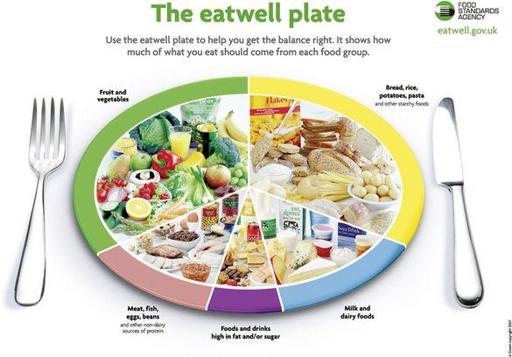Ross & Wilson Anatomy and Physiology in Health and Illness (123 page)
Read Ross & Wilson Anatomy and Physiology in Health and Illness Online
Authors: Anne Waugh,Allison Grant
Tags: #Medical, #Nursing, #General, #Anatomy

A balanced diet contains all nutrients required for health in appropriate proportions, and is normally achieved by eating a variety of foods. This is because no single food contains the correct proportions of all essential nutrients. If any nutrient is eaten in excess, or is deficient, health may be adversely affected. For example, a high-energy diet can lead to obesity, and an iron-deficient one to anaemia.
A balanced diet is important in maintaining a healthy body weight, which can be assessed by calculating body mass index (BMI) (
Box 11.1
).
Box 11.1
Body mass index: WHO classification
Calculation of BMI
Interpretation of BMI
| <16 | Severely underweight |
| 16–18.4 | Underweight |
| 18.5–24.9 | Normal range |
| 25–29.9 | Overweight |
| 30–39.9 | Obese |
| >40 | Severely obese |
Healthy eating, i.e. eating a balanced diet, requires a certain amount of knowledge and planning. An important dietary consideration is the amount of energy required. This should meet individual requirements. Daily energy requirements depend on several factors including basal metabolic rate (
p. 306
), age, gender and activity levels. Dietary carbohydrates, fats and proteins are the principal energy sources and fat is the most concentrated form. Dietary energy is correctly expressed in joules or kilojoules (kJ) although the older terms calories and kilocalories (kcal or Cal) are also still used in the UK.
This section is based on the recommendations of the
British Nutrition Foundation (2009)
. Recommendations for daily food intake sort foods of similar origins and nutritional values into food groups, and advise that a certain proportion from each group be eaten daily (
Fig. 11.1
). If this plan is followed, the resulting dietary intake is likely to be well balanced. The five food groups are:
•
bread, rice, potatoes, pasta
•
milk and dairy foods
•
foods and drinks high in fat and/or sugar
•
meat, fish, eggs, beans
•
fruit and vegetables.
Figure 11.1
The eatwell plate.
The main food groups and their recommended proportions within a balanced diet.
Reproduced with permission from the Food Standards Agency, UK.
Bread, rice, potatoes, pasta
The British Nutrition Foundation recommends that this group should make up one-third of the diet and that each meal should be based around one food from this group. Potatoes, yams, plantains and sweet potato are classified as ‘starchy carbohydrates’ and are, therefore, considered within this group rather than as fruit and vegetables. These foods are sources of carbohydrate and fibre that provide sustained energy release. Some also contain iron and B-group vitamins including folic acid (
p. 271
).
Milk and dairy foods
Foods in this group provide protein and minerals including calcium and zinc: some are also a source of vitamins A, B
2
and B
12
. They include milk, cheese, fromage frais and yoghurt, and often contain considerable amounts of fat. Intake should be limited to three servings per day.

Foods and drinks high in fat and/or sugar
These foods are illustrated in
Figure 11.1
and also include oils, butter, margarine (including low-fat spreads), mayonnaise, fried food including chips, crisps, sweets, chocolate, cream, ice cream, puddings, jam, sugar and soft drinks, but not diet drinks. Fats are classified as saturated or unsaturated and the differences between these are explained on
page 269
. Foods in this group should only be used sparingly, if at all, as they are high in energy and have little other nutritional value.
Meat, fish, eggs, beans
In addition to the food shown in
Figure 11.1
, this group includes meat products such as bacon, sausages, beefburgers, salami and paté. Moderate amounts are recommended because many have a high fat content. It is suggested that fish, including one portion of oily fish, e.g. salmon, mackerel, trout, sardines or fresh tuna, is eaten twice weekly. This food group provides protein, iron, vitamins B and D and sometimes minerals. Vegetarian alternatives include tofu, nuts, beans and pulses, e.g. lentils. Beans and pulses are also a good source of fibre.
Fruit and vegetables
Foods in this group include fresh, frozen and canned products, 100% fruit or vegetable juices and pure fruit smoothies. These foods provide carbohydrate, fibre, vitamin C, folic acid (
p. 9
) and fibre. A minimum of five portions per day is recommended.

Additional recommendations
The British Nutrition Foundation makes other specific recommendations about
salt
(
p. 272
) and
fluid intake
(1.5 to 2 l per day). This includes water, tea, coffee, squash and fruit juice.
Alcohol
intake should not exceed 3–4 units per day for men and 2–3 units per day for women.

Groups of people with specific dietary requirements
Certain groups of people may require a diet different from the principles outlined above. For example, pregnant and lactating women have higher energy requirements to support the growing baby and milk production. Menstruating women need more iron in their diet than non-menstruating women to compensate for blood loss during menstruation. Babies and growing children have higher energy requirements than adults because they have relatively higher growth and metabolic rates. In some gastrointestinal disorders there is intolerance of certain foods, which restricts that person’s dietary choices, e.g. coeliac disease (
p. 323
).
Digestion, absorption and use of nutrients are explained in
Chapter 12
. Structures and chemistry of carbohydrates, proteins and fats are described in
Chapter 2
.
Carbohydrates



